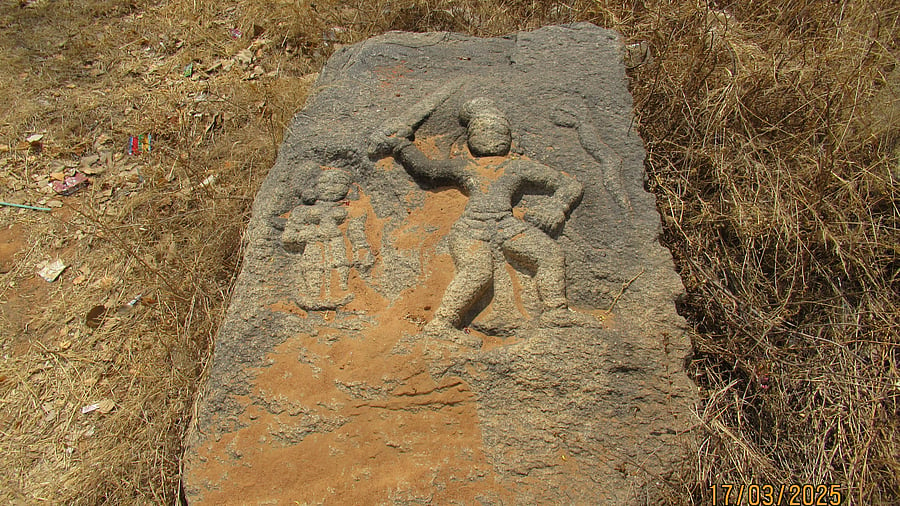
Credit: Special Arrangement
I was fascinated to learn about various temples and inscriptions at Dasanapura and Makali villages in Nelamangala taluk, mentioned in the Mysore Archaeological Survey (MAS) report for the year 1914–15. I decided to travel to these places to observe how development has changed the landscape over the past 11 decades.
Taking a Nelamangala-bound BMTC bus, I got down at Makali stop and asked for directions to the Bhimeshvara temple. A senior resident, Ramappa, told me to first visit the Bhimana Mandiooru near Gavipalya of Laxmipura village.
I walked to Madanayakahalli, took a bus to Laxmipura, and then walked to the Gavi Gutte temple, believed to be the place where Rishi Agasthya performed tapas. On the way to the temple, I came across a beautiful hero stone lying on the ground. The hero is depicted holding a dagger in his right hand, with his sati standing behind him. A snake is shown in front of him.
In front of the temple, an ancient pillar bears the image of Hanuman. I walked to the Bhimana Mandiooru temple. Here, it is believed, Bhima’s mandi (knee) created a depression in the rocky surface. The area is now overgrown with bushes and wild vegetation. A young boy, Bharat, who was travelling to Makali, offered me a ride on his scooter.
Makali, located on the right bank of River Arkavathi, was mentioned as a bechirakh (a Marathi word for uninhabited) village in the MAS report. Its population has grown from 39 in 1928, according to the Mysore Gazetteer, to 484 in 1990, according to the Karnataka State Gazetteer (KSG).
I walked toward the tall Hanuman statue of recent origin, visible from a distance and marking the entrance to the Bhimanjaneya Swami Punya Kshetra. I found the well-preserved Bhimeshvara temple, described in the MAS as “an old structure with doorways and lintels carved with rough scroll work,” located on the banks of the Arkavathi.
From Makali, I walked to Dasanapura village. The Ranganatha temple, “though so named, has the figure of Srinivasa, about 2 feet high,” as mentioned in the MAS. Right in front of the renovated temple stands a new Garuda pillar.
I searched for the ancient Garuda pillar, mentioned in the MAS as having a Hanuman on the side facing the temple instead of the usual Garuda. I found it standing quite far from the temple, amidst a pile of stones, almost touching the compound wall of a house in front of the temple.
The distance between the main idol and the old Garuda pillar offered a glimpse of the vastness of the original temple complex.
According to the Supplement to Epigraphia Carnatica Vol IX (1905), there was a 23-line inscription stone, located behind the Maramma temple, next to a raised platform. When I reached the Maramma temple, I discovered that, after recent renovations, a compound wall had been built around the raised platform, and the inscription stone — which the villagers remember seeing — is now missing.
The MAS also refers to another inscription, which was present in Range Gauda’s fields to the east of Dasanapura village. This inscription, ‘which appears to be dated in 1522’ according to the MAS, indicates the antiquity of the village. I was saddened to find that this inscription was also missing, with a large house now occupying the site.
As I boarded the bus for the return journey, I wished that while renovating temples or constructing houses, care would be taken to preserve the history attached to these places.
The ancient Garuda pillar in the narrow lane of Dasanapura.
Ancient Bhimeshwara temple on the banks of Arkavathi river.
The Gavi Gutte temple at Laxmipura village.